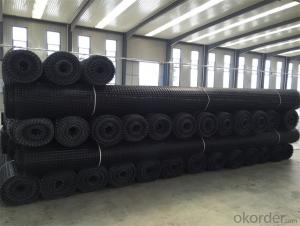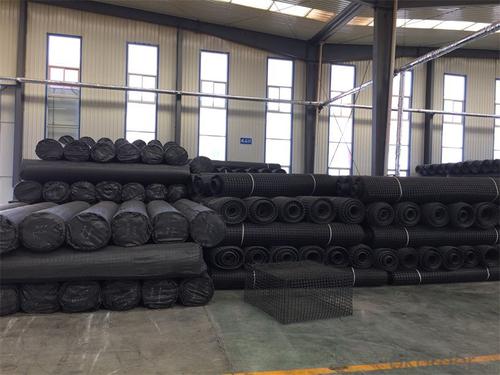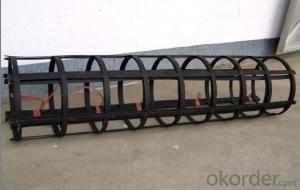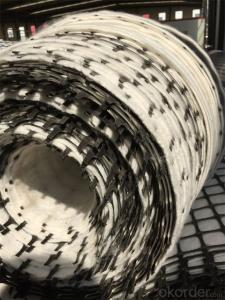Stable Access Routes Geogrids - PP Biaxial Plastic Geogrid with High Tensile Strength Warp Knitted Cmax
- Loading Port:
- Tianjin
- Payment Terms:
- TT OR LC
- Min Order Qty:
- 20000 m²
- Supply Capability:
- 50000000 m²/month
OKorder Service Pledge
OKorder Financial Service
You Might Also Like
Fiberglass Geogrid Introduction:
Fiberglass geogrid is a kind of planar mesh material using alkali-free fiberglass yarn as base body and then coated with high quality modified asphalt. It is warp knitted with oriental structure which gives full play of yarn strength and improves its mechanical property to make the product high tensile, tearing and creep-resistant. Moreover, the composite property of coating with asphalt makes full protection of the fiberglass matrix and greatly improves its wear and shear resistance. All the advantageous functions make the product have a good performance in pavement strengthening, track cracking and solving difficulties of strengthening the bituminous pavement.
Fiberglass Geogrid Features:
1. Light weight, high tensile strength, high modulus, low elongation and good toughness.
2. Corrosion resistance, no long-term creep, long life span.
3. Good physical and chemical stability and good thermal stability.
4. Resistant to fatigue cracking, high-temperature track and low temperature shrinkage cracking.
5. Delaying and decreasing crack reflection.
Specifications | PET20-20 | PET30-30 | PET40-40 | PET50-50 | PET80-80 | PET100-100 | PET120-120 |
Elongation(%) | 10%~15% | ||||||
Vert Tensile strength(KN/m) | 20 | 30 | 40 | 50 | 80 | 100 | 120 |
Horiz Tensile strength(KN/m) | 20 | 30 | 40 | 50 | 80 | 100 | 120 |
Grid(mm) | 12.5×12.5 20×20 24.5×24.5 | ||||||
Width(m) | 1—6 | ||||||
Fiberglass Geogrid Application:
1. Road surface asphalt overlay construction engineering; Asphalt layers
reinforcement.
2. Converting old cement concrete road into composite road; Restraining
reflection cracking caused by block shrinkage.
3. Road extension; Preventing and controlling the cracking caused by new
and old combination and uneven settlement.
4. Treatment of the conjunction between tunnel and bridge or foundation.
Packaging & Shipping:









FAQ:
1. How to order your geogrid ?
a) Tensile strength in warp & weft direction
b) Grid size
c) Roll Width and length
d) Quantity
2. What is the Payment term?
a) TT
b) LC AT SIGHT
c) cash
d) 30% contact value as deposit ,the blance 70% be paid after received the copy of bl .
3. Delivery time
a) 19-25 days after received your depsit .
4. What is MQQ ?
a) 2500 m2 as MQQ , we can also produce sample for you .
Welcome to send your inquiry to us, and if you have any question, we can also help you.
- Q: What is a geogrid?
- A geogrid is a type of geosynthetic material that is used to reinforce soil or other materials in civil engineering applications. It is typically made of polymer materials and has a grid-like structure that provides tensile strength and enhances the stability of the soil or other materials it is placed within.
- Q: Geogrid TX160 what does that mean?
- The geogrid is made of polypropylene, polyvinyl chloride and other high molecular weight polymers by hot pressing or molding
- Q: Are geogrids suitable for use in soft soils?
- Yes, geogrids are suitable for use in soft soils. Geogrids are designed to provide reinforcement and stabilization to weak soils, including soft soils. They help to distribute loads and improve the overall strength of the soil, making them an effective solution for construction projects in areas with soft soil conditions.
- Q: What are the differences between geogrids and geopipes?
- Geogrids and geopipes are both geosynthetic materials used in civil engineering and construction projects, but they serve different purposes. Geogrids are typically made of high-strength polymers or metals and are used to reinforce soil, providing stability and enhancing load-bearing capacity. They are commonly used in applications such as retaining walls, slope stabilization, and road and pavement construction. Geogrids have an open structure with interlocking apertures, allowing soil particles to interlock with the material, creating a strong composite. On the other hand, geopipes are typically made of high-density polyethylene (HDPE) and are used for subsurface drainage and water management systems. They have a perforated or slotted design that allows for the efficient collection and transportation of excess water from the soil. Geopipes are commonly used in applications such as underdrains, French drains, and stormwater management systems. In summary, geogrids are used for soil reinforcement and stability, while geopipes are used for subsurface drainage and water management.
- Q: Can geogrids be used in slope protection systems?
- Yes, geogrids can be used in slope protection systems. Geogrids are commonly used to reinforce slopes by providing stability and preventing soil erosion. They can be installed horizontally or vertically to improve the strength of the soil and enhance the overall performance of slope protection systems.
- Q: How do geogrids help in reducing the use of natural resources?
- Geogrids help in reducing the use of natural resources by enhancing the stability and strength of soil, thus reducing the need for excessive excavation and the use of traditional construction materials like stone or concrete. This results in less dependence on natural resources and promotes sustainability in construction projects.
- Q: How do geogrids help in reducing settlement of foundations?
- Geogrids help in reducing settlement of foundations by providing reinforcement and stability to the soil. They distribute the load more evenly, preventing differential settlement and soil consolidation. Additionally, geogrids increase the tensile strength of the soil, minimizing deformation and settlement over time.
- Q: Can geogrids be used in bridge abutment reinforcement?
- Yes, geogrids can be used in bridge abutment reinforcement. Geogrids are commonly used in civil engineering projects to enhance soil stability, prevent soil erosion, and provide reinforcement. They can be used to reinforce the backfill material behind bridge abutments, improving their overall stability and load-bearing capacity.
- Q: What are the benefits of using geogrids in construction projects?
- Geogrids offer several benefits in construction projects. Firstly, they provide increased stability and reinforcement to soil structures, enhancing their load-bearing capacity. This can reduce the need for excessive excavation and the use of additional materials, leading to cost savings. Geogrids also prevent soil erosion by distributing forces more evenly, reducing the risk of slope failures or surface damages. Furthermore, they improve the longevity and durability of structures by minimizing settlement and lateral movement. Overall, geogrids are an effective and sustainable solution that improve the performance and efficiency of construction projects.
- Q: Do geogrids affect groundwater flow?
- No, geogrids do not affect groundwater flow.
Send your message to us
Stable Access Routes Geogrids - PP Biaxial Plastic Geogrid with High Tensile Strength Warp Knitted Cmax
- Loading Port:
- Tianjin
- Payment Terms:
- TT OR LC
- Min Order Qty:
- 20000 m²
- Supply Capability:
- 50000000 m²/month
OKorder Service Pledge
OKorder Financial Service
Similar products
Hot products
Hot Searches
Related keywords






























